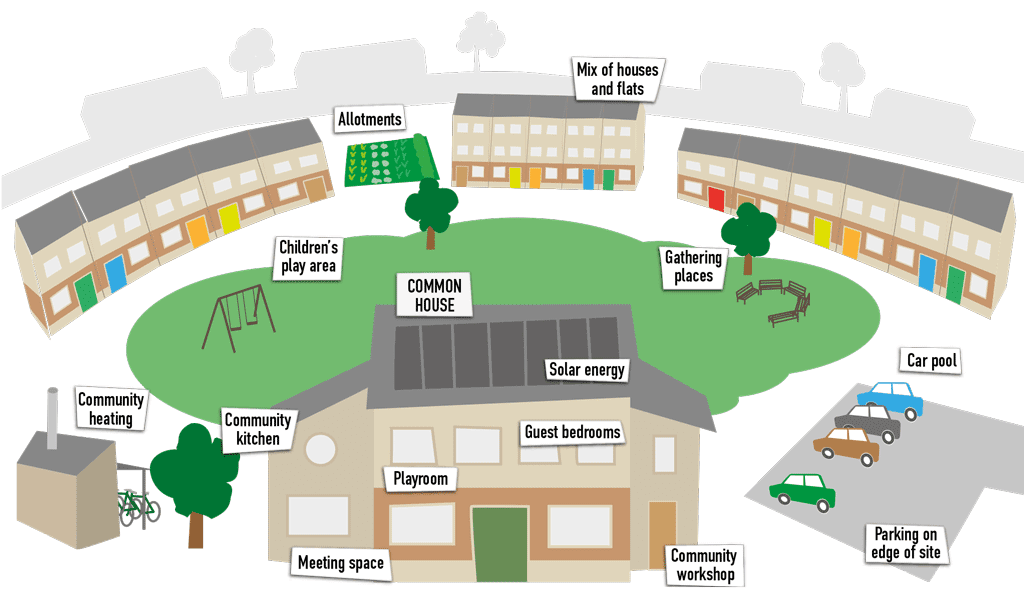Cohousing is an innovative approach to creating a community where people live intentionally and collaboratively. Often referred to as an intentional community, cohousing is designed by its residents to reflect shared values and foster a supportive, connected, and environmentally conscious way of living.
At its core, cohousing brings people together to build neighborhoods that embody specific values. These values often revolve around enhancing connectivity among residents, promoting mutual support, and living sustainably. Unlike traditional neighborhoods, cohousing developments are planned with both private and communal spaces, striking a balance between individual privacy and community interaction.
Key Characteristics of Cohousing
- Balance Between Privacy and Community: Cohousing is designed to offer a blend of private homes and communal spaces. Residents have their own living areas but also access shared spaces where they can gather, eat, and socialize.
- Optimal Size for Interaction: Cohousing developments typically consist of 10-40 households. This size range facilitates easier interactions and helps build a strong sense of community.
- Resident-Driven Decision Making: Decisions in cohousing communities are often made by consensus, ensuring that all residents have a voice in how their community is run.
- Inclusivity and Community Integration: Cohousing communities strive to be inclusive and are often integrated into the broader community, promoting diversity and social cohesion.
Distinguishing Cohousing from Communes
While cohousing emphasizes communal living, it is distinct from communes. In cohousing, residents have their own private homes but share common areas and resources. The goal is not to enforce communal activities but to provide spaces where residents can choose to interact and share when they wish.
Cohousing in Practice
There are currently 19 cohousing developments across the UK, with more than 60 in various stages of development. These communities vary widely, with some being intergenerational, others focusing on independent living for people with disabilities, and some catering to specific groups such as older women or LGBT communities.
Senior Cohousing
Senior cohousing is gaining popularity as a solution to the challenges faced by older adults, including loneliness and the need for adaptable living environments. As people live longer, the demand for housing that supports independence and social connection increases. Research indicates that loneliness can increase the likelihood of death by 26%, underscoring the importance of community living for older adults.
Senior cohousing is gaining popularity as a solution to the challenges faced by older adults, including loneliness and the need for adaptable living environments. As people live longer, the demand for housing that supports independence and social connection increases. Research indicates that loneliness can increase the likelihood of death by 26%, underscoring the importance of community living for older adults.
Benefits of Cohousing
Cohousing offers numerous advantages, including:Social Transformation: Promoting solidarity and diversity within the community.
Environmental Sustainability: Encouraging the responsible use of natural and energy resources.
Economic Viability: Offering an affordable housing option through shared resources and communal living.
Global Perspective
Cohousing originated in Denmark in the 1960s and has since spread globally, particularly to the US and Nordic countries. It is seen as a social response to housing challenges, especially for vulnerable groups like the young and the elderly. Cohousing combines architectural innovation with principles of community living, cooperation, and shared ownership.
The Process of Establishing Cohousing
Cohousing typically starts with a small group of individuals with shared interests and life philosophies. These founding members design the community based on their collective needs, creating a mix of private homes and shared spaces such as kitchens, dining rooms, and green areas. Essential services like cleaning, gardening, and childcare are also shared, fostering a sense of mutual support.
Models of Property Ownership
The most common ownership model in cohousing is a housing cooperative with the right of use. This means that while the buildings belong to the cooperative, residents have lifelong rights to live in and use the communal areas. This model makes it easy for residents to move within the community, transfer their rights, or sell them through the cooperative.
The most common ownership model in cohousing is a housing cooperative with the right of use. This means that while the buildings belong to the cooperative, residents have lifelong rights to live in and use the communal areas. This model makes it easy for residents to move within the community, transfer their rights, or sell them through the cooperative.
Conclusion
Cohousing represents a sustainable and inclusive housing model that promotes community, cooperation, and responsible resource use. It offers a viable solution to the growing challenges of housing affordability, social isolation, and environmental sustainability. Whether for older adults, specific community groups, or those seeking a more connected way of living, cohousing provides a framework for creating supportive and resilient communities.
Cohousing represents a sustainable and inclusive housing model that promotes community, cooperation, and responsible resource use. It offers a viable solution to the growing challenges of housing affordability, social isolation, and environmental sustainability. Whether for older adults, specific community groups, or those seeking a more connected way of living, cohousing provides a framework for creating supportive and resilient communities.


